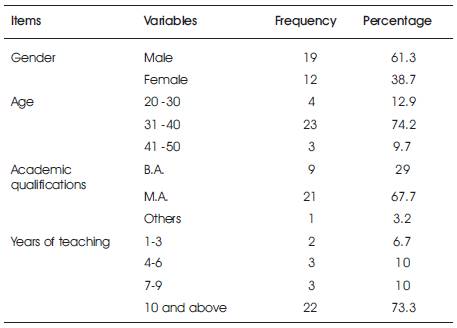
Table 1. Teachers' Characteristics.
Large scale tests have been considered by many scholars in the field of language testing and teaching to influence teaching and learning considerably. The present study looks at the effect of a large scale test (Konkoor) on the attitudes of teachers in high schools. Konkoor is the university entrance examination in Iran which is taken by at least one million candidates of entering Iranian universities. The data for the study comes from a questionnaire answered by high school teachers in Iran. Analyses of the results indicate that Konkoor influences teachers' attitudes regarding different aspects of the language teaching program in Iran.
Elton and Laurillard (1979) state that “the quickest way to change student learning is to change the assessment system” (p. 100, as cited in Tang & Biggs, 1996, p. 159). This quotation emphasizes the strong effect tests can have on education. This influence of testing on teaching and learning has been referred to as washback effect (Alderson, 1986; Alderson & Wall, 1993; Davies, 1976; Gates 1995; Hughes, 1989; Kellaghan et al., 1982; Khaniya, 1990a & b; Morrow, 1986; Pearson, 1988; Prodromou, 1995; Wiseman, 1961).
According to Buck (1988), washback effect can be either harmful (negative) or beneficial (positive). It is harmful when teaching test-taking strategies and coaching can highly inflate the scores and when it has the effect of narrowing the curriculum.
On the other hand, when the test reflects the general objectives of the educational program, washback effect can have the advantage of encouraging the stakeholders to strive towards achieving those goals. According to Taylor (2005), positive washback is said to result when a testing procedure encourages 'good' teaching practice. However, though for many years it was just assumed that 'good tests' would produce 'good washback' and inversely that 'bad tests' would produce 'bad washback,' it is much more complex than this, as Alderson and Wall (1993) have shown.
The importance of washback effect is so high that some suggest that, in addition to validity, reliability and practicality, washback effect also be a criterion for evaluating a test. According to Pilliner (1973), tests should be educationally beneficial and allow users to take positive washback for granted. As Hughes (1988) states.
...where relevant, potential washback effect should join validity and reliability in the balance against practicality. If this were always done, one might find that there were fewer conflicts between teaching and testing than appear to exist today. (p. 146)
The university entrance examination in Iran (Konkoor) is a comprehensive test taken every year by a large number of people who want to enter Iranian universities all over the country. As this test is highly important to the future of the students, it is claimed to affect the way of teaching and learning in Iranian schools, especially high schools. The form of the test is multiple-choice and the content is mainly grammar-based with vocabular y and reading comprehension sections as well. Therefore, if the test really influences the teaching and learning of English in Iranian schools, it encourages teaching the test taking strategies as well as focusing on improving the students' linguistic competence (the knowledge of language) rather than their communicative competence.
The large bulk of Konkoor preparation materials and classes both inside and outside the schools suggest that Konkoor is highly influencing the way of teaching and learning English in Iran. However, although a lot has been said regarding the washback effect of Konkoor on English teaching in Iran, little experimental research has been carried out investigating the issue.
The scope of the effects of Konkoor may not be limited to teachers and students, but to the society and the educational system as well in which case it is referred to as test impact rather than test washback by Bachman and Palmer (1996) and Wall (1997). According to Wall, impact refers to “. . . any of the effects that a test may have on individuals, policies or practices, within the classroom, the school, the educational system or society as a whole”, whereas washback (or backwash) is defined as “the effects of tests on teaching and learning” (p. 291).
Methodology
This study is concerned with the washback effect of Konkoor on teachers' attitudes toward their own teaching as well as the teaching context. The data for the study comes from teachers' completing a teacher attitude questionnaire.
Subjects
English teachers at high schools at Khorram Abad were surveyed. Of the 45 questionnaires distributed among the teachers, 36 were returned 5 of which were discarded due to careless answers. The final number of questionnaires analyzed in the study was 31.
Instruments
The questionnaire used to get data is the revised format (see the Appendix) of the teacher questionnaire designed by Cheng (2004) for a similar purpose. The Revised Teacher Questionnaire (RTQ) consisted of three parts, and was designed and administered in English. Part One consisted of four categories of teachers' personal details (gender, age, academic qualifications, and years of teaching). Part Two consisted of 9 categories and 69 items altogether (Q1.1 to 9.12). All of them were designed on a 5-point Likert scale of agreement, where 5 = Strongly Agree, 4 = Agree, 3 = Undecided, 2 = Disagree, and 1 = Strongly Disagree, regarding teachers' perceptions of selected aspects of teaching, learning and assessment, and evaluation. Part Three consisted of 2 categories, which were concerned with teachers' ideas regarding the omission of Konkoor and their attitudes toward the main function of textbooks in teaching. These two categories were designed for teachers to select answers according to their ideas and attitudes.
Data analysis
The results of the questionnaire were analyzed using SPSS (Version 14). First, frequency distributions were calculated for all the questionnaire items, and missing values of each item were replaced by the items' mean value. All percentages were reported as valid percentages with missing data excluded.
Four teachers' characteristics were studied (Table 1). Around 60 percent of the teacher participants were male and about 40 percent female. Most of them (around 75 percent) were between 31 to 40years of age, held M.A. degree (around 70 percent), and had 10 or more years of teaching experience (around 75 percent).

Table 1. Teachers' Characteristics.
Teachers' Attitudes Regarding The Major Aims of English Learning
Descriptive analysis of the answers to question 1 in part 2 (Q1) indicated that the major purpose of studying English in Iran is to pass examinations (Table 2). As Konkoor is a very important examination in the educational life of students, this suggests that this exam has a washback effect on the teachers' perceptions of the goals of language learning in the country.
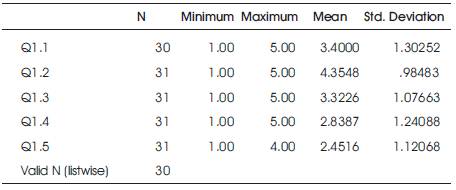
Table 2. Descriptive Statistics of the answers to Question 1 in part 2.
The second aim chosen by the teachers was “to pursue further studies.” The mean for this option (3.4000) stands somewhere between “undecided” and “agree” suggesting that most of the teachers do not agree with this option as the main objective of learning English in Iran.
In order to know teachers' preferences for motivating students to learn English, descriptive statistics for Q2 was carried out. The results showed that they agreed more with “creating a positive attitude toward language learning” rather than “doing more mock exam papers” which was the last frequently chosen option by the teachers (Table 3). The next options with which most teachers agreed (mean= 4.1290; mean= 4.0323) were “to provide students with effective language learning strategies” and “to give students more encouragement to learn” respectively. This indicates that if mock exams are done in these classrooms, it is just because of the teachers' feeling that they have to prepare their students for exams (especially Konkoor) rather than their willingness to motivate students.
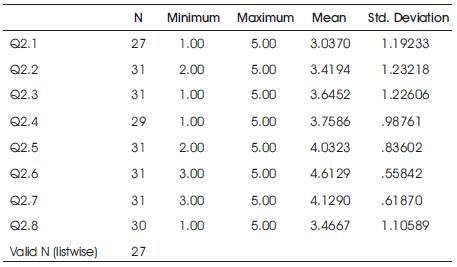
Table 3. Descriptive Statistics for Q2.
Teachers' Perceived Feeling of Konkoor Pressure on their Teaching
In question 3 in part 2 (Q3), the teachers were asked about the kind of extra work or pressure they felt Konkoor put on their teaching. The response “agreed” to “strongly agreed” with was “organizing more exam practices” based on descriptive analysis carried out for this part (Table 4). The next option agreed with was “preparing materials for students” (mean= 4.0000). The comparison between these two options as well as the results of this and the previous questions (Q3 & Q2) indicates that although teachers are not willing to use mock tests in their classes, they think they have to do it under the pressure of Konkoor. Hence, a very important washback effect of Konkoor.
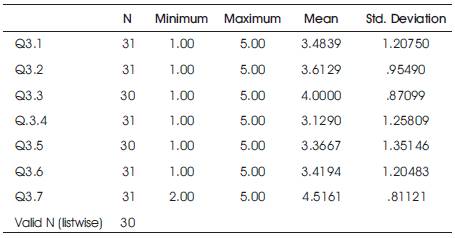
Table 4. Descriptive Statistics for Q3.
Teachers' Perception of Major Changes in Teaching Needed Under the Influence of Konkoor
Based on the analysis of answers to question 4 (Q4), the only change most teachers thought they had to make in their teaching due to Konkoor was “to teach according to the Konkoor test formats” (Table 5).
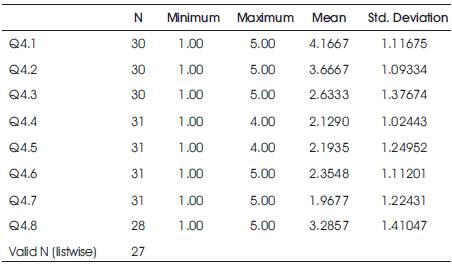
Table 5. Descriptive Statistics for Q4.
Learning Strategies Suggested by Teachers Under the Influence of Konkoor
Descriptive analysis was also carried out for Q5 which was concerned with the learning strategies that teachers suggest their students to use due to Konkoor (Table 6). None of the options had a mean of 4.0000 or more. The learning strategy with the highest mean (3.6129) was “to learn to jot down better notes.” Compared with the other options of this question such as “expose themselves to various English media,” “to learn to express their opinions in class,” “to put more emphasis on listening and speaking,” etc. (See the Appendix), the first selected option is the one most directly related to preparation activities for Konkoor.
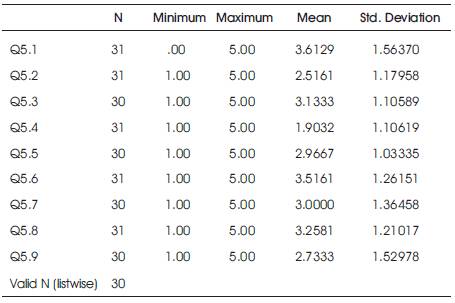
Table 6. Descriptive Statistics for Q5.
Teachers' Perception of Types of Activities Needed Under The Influence of Konkoor
Descriptive analysis carried out for Q6 showed that teachers agreed that the activity they should have in their classes due to Konkoor was “training in basic language knowledge” (Table 7).
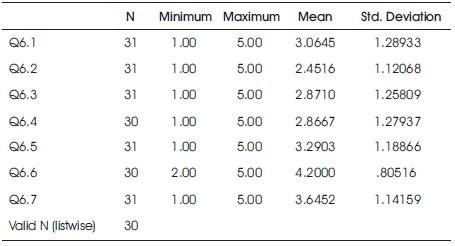
Table 7. Descriptive Statistics carried out for Q6.
Like Q5, compared with the other options of this question such as “task-oriented activities,” “exposure to various English media,” “authentic materials,” etc. (See the Appendix), the option “most agreed” with was the one most directly related to preparation activities for Konkoor.
Teachers' Perception of The Main Functions of Mock Tests In Their Classes
In analyzing teachers' perceptions of the main functions of mock tests (Table 8), the two options “most agreed” with were “to give feedback to teachers” (mean= 4.2500) and “to prepare students for public examinations” (mean= 4.1852), respectively. The difference between the two was not significant at 0.05 suggesting that both of them were important at the same level. Although the second one seems to be more under the influence of Konkoor, the first one, too can be related to Konkoor.
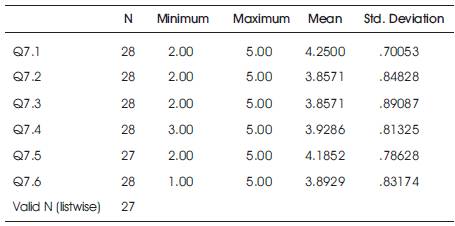
Table 8. Descriptive analysis teachers’ perceptions of Mock tests.
Teachers' Perception of The Schools' Way of Assessment of their Teaching
The analysis of question 8 related to teachers' perceptions regarding the schools' way of assessing their teaching (Table 9) indicates that teachers agreed that they were assessed based on “the performance of their students in tests and public exams like Konkoor”.
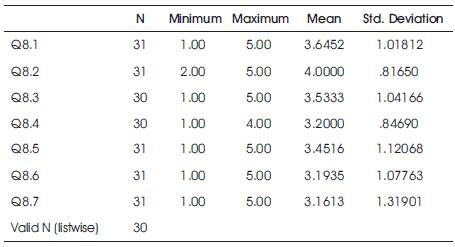
Table 9. Descriptive Statistics for Q8.
Teachers' Perception of the Factors Influencing their Teaching the Most
According to the descriptive analysis of Q9 (Table 10), the factors that teachers thought influenced their teaching the most were the teachers' “past experience as a language learner,” “teaching experience and belief,” and “teaching syllabus.” The first factor agreed upon by most teachers, that is, their past experience as a language learner can reflect the influences of Konkoor since they have experienced the same situation as their present students regarding having to take Konkoor in order to continue their education. The other two options, too are related to the effect of Konkoor though indirectly.
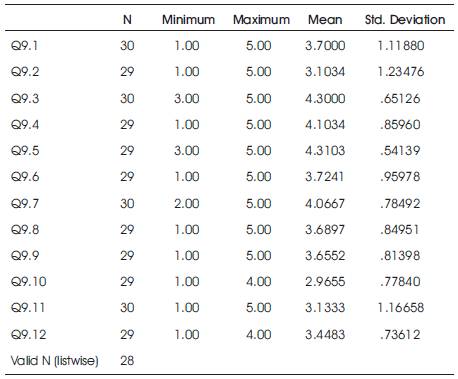
Table 10. Descriptive Statistics for Q9.
Teachers were asked about their opinion regarding the omission of Konkoor. Almost half of the teachers (48.4) welcomed the change, while around one third (35.5) were skeptical about the change (Table 11).
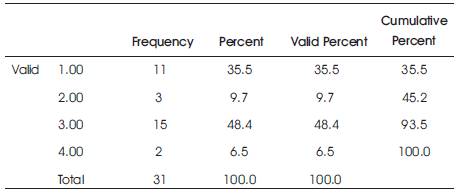
Table 11. Analysis of % regarding the omission of Konoor.
Teachers' Perception of the Main Functions Textbooks in Teaching
Teachers were asked about the primary functions of textbooks in teaching. Around 60 percent believed that books were primarily “to provide a structured language program to follow” (Table 12). Interestingly the option “to provide information about the language” was not chosen at all.
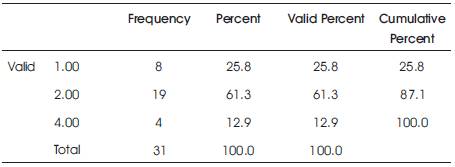
Table 12. Analysis of % for the primary functions of textbooks.
The findings of the present study approve the washback effect of Konkoor on teachers' attitudes toward their teaching. The analysis of the different parts of the questionnaire reveals that Konkoor is a determinant factor influencing different aspects of the high school teachers' teaching based on their own attitudes. According to their attitudes, teachers feel some pressure, need to change their way of teaching, recommend certain learning strategies, etc. under the influence of Konkoor. The survey also reveals that the goals of language learning as well as standards for assessing language teachers' success are influenced noticeably by the high stakes nature of Konkoor.
Therefore, the findings imply that if there is a need to change the way of language teaching and learning in Iran, it requires a change in the format and content of Konkoor. Konkoor determines to a large extent what to do in the language classroom and obviously, a change in this test follows changes in the way language is taught in schools. It is recommended that the content of Konkoor become more directed toward the communicative use of language in real like situations so that its influence on the language classrooms is less negative for language teachers and learners.
| Gender: | [ ] Male | [ ] Female |
| Age: | [ ] 20-30 | [ ] 31-40 |
| : | [ ] 41-50 | [ ] above 50 |
| Academic Qualifications: | [ ] B.A. | [ ] M.A. [ ] Others |
| Years of Teaching: | [ ] 1-3 | [ ] 4-6 |
| : | [ ] 7-9 | [ ] 10 & above 10 |
| 1=Strongly disagree, | 2=Disagree, | 3=Undecided, |
| 4=Agree, | 5=Strongly agree. |
Put 1, 2, 3, 4, or 5 in the brackets provided.
(1) What do you think the major aims for learning English in Iran are?
1 [ ] To pursue further studies
2 [ ] To pass examinations
3 [ ] To obtain jobs
4 [ ] To satisfy school requirements
5 [ ] To satisfy parents' requirements
(2) In what ways do you think you would like to motivate your students to learn English?
1 [ ] To do more mock exam papers
2 [ ] To use more authentic materials
3 [ ] To organize real life language activities
4 [ ] To do more interesting language games
5 [ ] To give students more encouragement to learn
6 [ ] To create a positive attitude toward language learning
7 [ ] To provide students with effective language learning strategies
8 [ ] To have better classroom discipline
(3) What kind of extra work or pressure if any do you think Konkoor puts on you in your teaching?
1 [ ] Following a certain syllabus
2 [ ] Doing more lesson preparation
3 [ ] Preparing more materials for students
4 [ ] Employing new teaching methods
5 [ ] Setting up specific teaching objectives
6 [ ] Meeting specific challenges in teaching
7 [ ] Organizing more exam practices
(4) What are the major changes you think you have to make in your teaching under the influence of Konkoor?
1 [ ] To teach according to the Konkoor test formats
2 [ ] To adopt specific teaching methods
3 [ ] To use a more communicative approach in teaching
4 [ ] To put more stress on role play and group discussion
5 [ ] To put more emphasis on the oral and listening components
6 [ ] To put more emphasis on the integration of skills
7 [ ] To employ more real life language tasks
8 [ ] To encourage more students' participation in class
(5) What are the learning strategies you usually recommend to your students due to Konkoor?
1 [ ] To learn to jot down better notes
2 [ ] To Expose themselves to various English media
3 [ ] To learn to express their opinions in class
4 [ ] To put more emphasis on listening and speaking
5 [ ] To learn to initiate questions
6 [ ] To be more active in classroom participation
7 [ ] To use English more in their daily life
8 [ ] To change from passive learning to active learning
9 [ ] To communicate more in English
(6) What types of activities do you think should be involved with language learning due to Konkoor?
1 [ ] Task-oriented activities
2 [ ] Language games
3 [ ] Role play and group discussion
4 [ ] Exposure to various English media
5 [ ] Authentic materials
6 [ ] Training in basic language knowledge
7 [ ] Extracurricular activities
(7) What do you think are the basic functions of mock tests in school?
1 [ ] To give feedback to teachers
2 [ ] To assess students' learning difficulties
3 [ ] To motivate students
4 [ ] To direct students' learning
5 [ ] To prepare students for public examinations
6 [ ] To identify areas of re-teaching
(8) How is your teaching assessed in your school?
1 [ ] Your own reflections on teaching
2 [ ] The performance of your students in tests and public exams like Konkoor
3 [ ] The overall inspection of your students' work by your school
4 [ ] The overall completion of the subject contents
5 [ ] Anonymous student evaluation of teaching
6 [ ] Evaluation by colleagues
7 [ ] Evaluation by principal or school inspectors
(9) What are the factors that most influence your teaching?
1 [ ] Professional training
2 [ ] Academic seminars or workshops
3 [ ] Teaching experience and beliefs
4 [ ] Teaching syllabus
5 [ ] Past experience as a language learner
6 [ ] The need to obtain satisfaction in teaching
7 [ ] Textbooks
8 [ ] Public examinations
9 [ ] Learners' expectations
10 [ ] Peers' expectations
11 [ ] Principal's expectations
12 [ ] Social expectations
(1) What is your idea about the omission of Konkoor?
1 [ ] Skeptical about the change
2 [ ] Neutral
3 [ ] Welcome the change
4 [ ] Enthusiastically endorse the change
(2) What are the primary functions of textbooks in teaching?
1 [ ] To provide practical activities
2 [ ] To provide a structured language program to follow
3 [ ] To provide language models
4 [ ] To provide information about the language